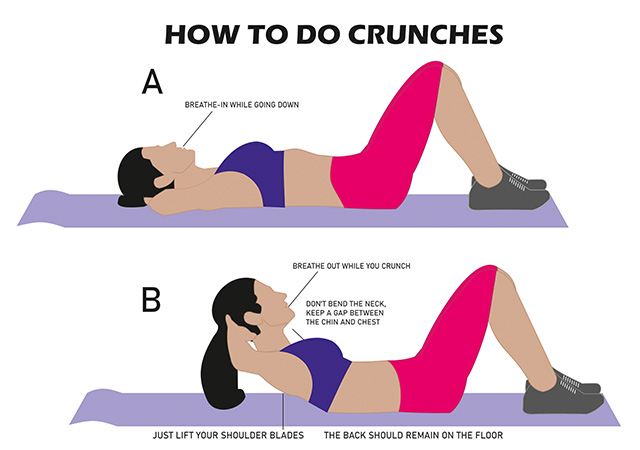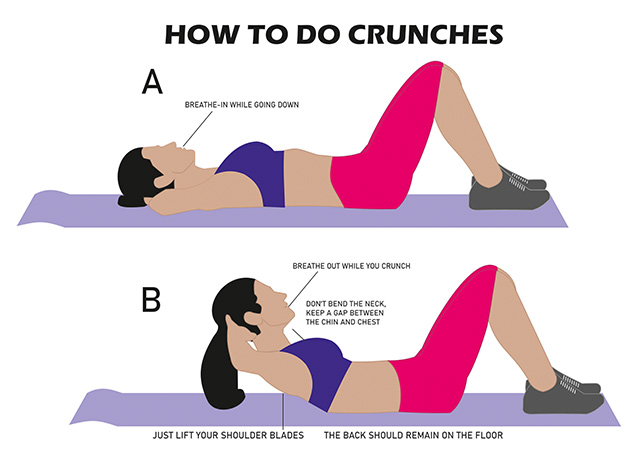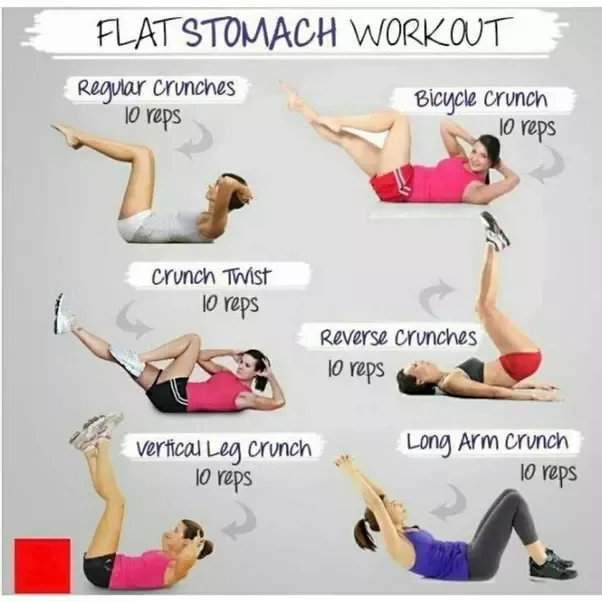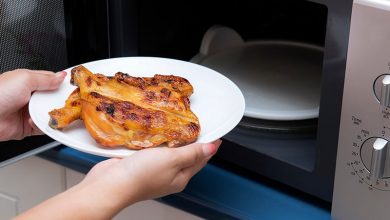How to do Crunches (Step-by-Step Guide 2023)

Do you want to add a simple core exercise to your program to help you get a six-pack? Crunches are the ideal supplement to help your abdomen become stronger and more toned. We have provided you with the basic steps on how to do crunches.

There is no special equipment required, so you may perform ab crunches anywhere there is enough room. To try to hit every muscle in your core, there are a ton of variants.
To acquire those rock-hard abs, keep reading as we’ll show you how to properly perform crunches and other common options.
Things you should know about how to do crunches
Here are a few tips to get started with the crunches exercise:
- Ensure your legs are bowed, your feet flat on the floor, and your back completely flat.
- Engage your abs while crossing your arms across your chest.
- As you raise your head and shoulders off the floor, pause for one or two counts. Lower yourself back down gradually.
- Try to perform 2-3 sets of 10-15 reps each.
How to do Crunches: Method 1

Below is the first method on how to do crunches:
For Proper Crunches
Follow the steps below to do proper crunches:
1. Lie on top of your back on the exercise mat
Locate an area on the floor where you can lay out and feel at ease. Throughout your workout, maintain a straight back and neck and push your lower back firmly into the mat.
To make crunches more comfortable if you don’t have an exercise mat, spread out a soft towel or perform them on a carpeted floor.
2. Bend your knees so your feet are flat on the floor
Put your feet in a position where your heels are between 12 and 18 inches (30 and 46 cm) from your tailbone. Maintain a hip-width distance between your knees while bending them 90 degrees. Ensure that the bottoms of your feet are flat against the surface.
3. Cross your arms in front of your chest
Continue to keep your elbows pointing down toward your feet. In front of your shoulders, flatten your hands on your chest.
- Avoid placing your hands behind your head when performing an activity since you could unintentionally strain your neck.
- Hold a 5 to 10-pound (2.3 to 4.5 kg) plate weight over your chest during your exercise to add greater resistance.
4. Lift your shoulder blade off the mat with a smooth controlled motion
As you inhale deeply, contract your abdominal muscles. To lift your torso off the surface, contract your muscles as you exhale. Just enough lifting is required so that your shoulder blades are raised off the ground. For one to two seconds, maintain this posture.
- Lower back discomfort might result from lifting your entire torso off of the ground. When you sit up all the way, your hip flexors also take over. Compared to a full sit-up, a crunch is a better ab workout.
- At all times, maintain contact with the mat with your feet, tailbone, and lower back. Have someone hold onto your feet or place them under something heavy if they lift off the ground while you are executing a rep.
- Instead of tucking your chin in, keep your neck flexible. Try to maintain your chin and chest separated by an apple’s width. You can prevent your neck from craning too far by looking up at the ceiling.
5. Lower yourself back down with a slow steady motion
Take a deep breath in as you slowly lower your torso to the ground. Your abdominal muscles will be worked more effectively and safely by using smooth, controlled actions as opposed to dropping back down. To complete 1 rep, pause momentarily.
- Rushing into the next rep increases your risk of back injury since you’ll use momentum rather than your muscles to lift yourself.
- To begin toning your abs, try performing a set of 10–12 crunches. Try adding to performing 2-3 sets or increasing the number of reps you perform as your core strength begins to develop.
Method 2
For Reverse Crunches
1. Lie on your back with your arms by your side
With your palms facing down, begin by reclining on your towel or exercise mat. Keep your neck and back straight when gazing up.
- Extend your arms to the sides so your body resembles the letter “T” if you require additional support.
- Reverse crunches are ideal for addressing your lower abs while traditional crunches focus on your top and middle abs.
2. Raise your legs to bring your knees
Lift your feet off the floor as you contract your abs. Bring your knees up to 90 degrees and directly above your hips.
- As you pull your legs up, keep in mind to move slowly and deliberately. To aid in maintaining control and balance, press your arms firmly into the ground.
3. Lift your hips and tailbone off the mat
As you inhale, relax. Lift your hips gradually off the mat as you exhale. Knees should remain at 90-degree angles as you move them closer to your head. Hold the position for one to two seconds after lifting your tailbone off the floor.
- While you’re exercising, keep your upper body, arms, and head firmly on the floor. Instead of using your arms to power your lift, press your arms down to maintain balance. Persist in concentrating on allowing your core muscles to carry the load.
4. Lower your hips to the floor with a controlled motion
As you return your hips back to the floor in a gentle, fluid motion, inhale. Maintain 90-degree angles in your knees, which should be placed directly over your hips. To complete your rep, take a brief pause while in this position.
- If you intend to perform further reps, keep your legs up; when you’re done, lower them.
- At each set, attempt to perform 10–12 reverse crunches. If it’s simple, increase the number of repetitions to 15 or 20.
Method 3
For Variation
1. Do over-head crunches to add more resistance
Stretch your arms straight out past your head so they are parallel to your back as you begin on your back with your legs bent. Lift your upper body off the floor while maintaining an extended arm position. Hold the position with your shoulder blades up for a few seconds before lowering yourself back down.
- Your abs have to work harder since your arms are extended, which adds a little extra weight. You might carry a plate weight or kettlebell in your hands for an even bigger challenge.
2. Try bicycle crunches for an all-round ab workout
Knees bowed and feet flat on the floor, start out on your back. Straighten out your right leg and raise your left leg toward your chest as if you were peddling a bicycle. Put your fingertips behind your head, raise your upper back off the floor, and turn your body such that your right elbow is pointing at your left knee.
- Next, extend your left leg while bringing your right knee toward your chest. At the same time, turn your torso so that your left elbow is in close proximity to your right knee.
- For each side of your body, try to perform 10–12 reps.
- The upper and lower abs, as well as the obliques, are the focus of bicycle crunches.
- Never jerk your head or neck with your hands; always move slowly and smoothly.
3. Perform side crunches to target your obliques
On your back, with your knees bent, lie down. Then, slant your hips to the left and bend your knees. Using the same methods as a standard crunch, place your hands over your chest and lift your upper back off the surface.
- With your legs dropped to the left, perform 10–12 crunches. Then, repeat the process to perform another set on your right side.
- Side crunches work the side muscles that are often worked during traditional crunches to increase strength and tone.
4. Practice doing side crunches on an [exercise ball] to stabilize your core
Your feet should be flat on the floor and hip-width apart as you sit on an exercise ball. Engage your abs while crossing your arms in front of your chest. Leaning back slowly, maintain a straight back. When your abdominal muscles begin to contract, hold the position for one to two counts before going back to your beginning position.
- Your lower body will be less stable when using exercise balls, so your abs will have to work more to keep you in place.
5. Try inclined crunches for a more intense ab workout
Position your body at a 45-degree angle while lying on a decline exercise bench. Your arms should be crossed over your chest as you hook your legs into the bench’s supports. Utilize your core the following time you exhale to lift your upper body off the bench. Before slowly lowering yourself back to the bench, hold your torso aloft for a few seconds.
- If you can, attempt to complete 10 repetitions, but if not, just try to complete as many with slow, controlled motions as you can.
- This exercise puts a greater strain on your core because you have to elevate your upper body higher
6. Mix up your routine with cable crunches
Hold on to the handle attachments as you kneel in front of a cable pulley machine. Take hold of the handles and draw them close to your sides. Inhale deeply, then tighten your abdominal muscles as you exhale. Keep your hips firmly planted while driving your elbows into your thighs while curling your back. Before going back to your starting position, hold the position for one to two counties.
- Try to perform 10–12 repetitions with calm, smooth motions. To avoid having your movements be powered by momentum, pause between each rep.
- Rather than tucking your chin in, maintain a neutral neck position. Keep an apple-sized distance between your chin and chest at all times.
- If you find it easier to perform cable crunches, try increasing the weight or performing more repetitions to develop more muscle.
You may want to watch the YouTube video here to learn more.
Related:
22 Fast Home Remedies to Get Rid of a Cough
How to Make Atmosphere in Little Alchemy 2




